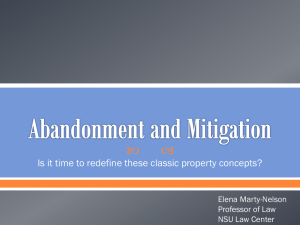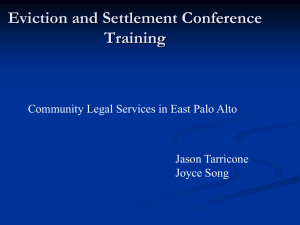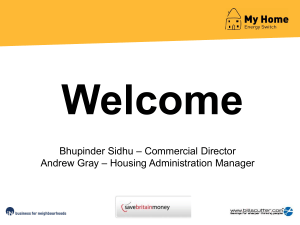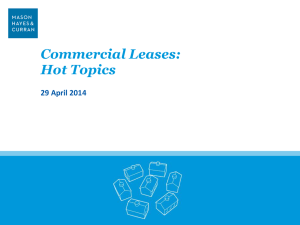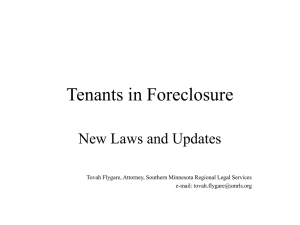CMI on Tenant Productivity
advertisement
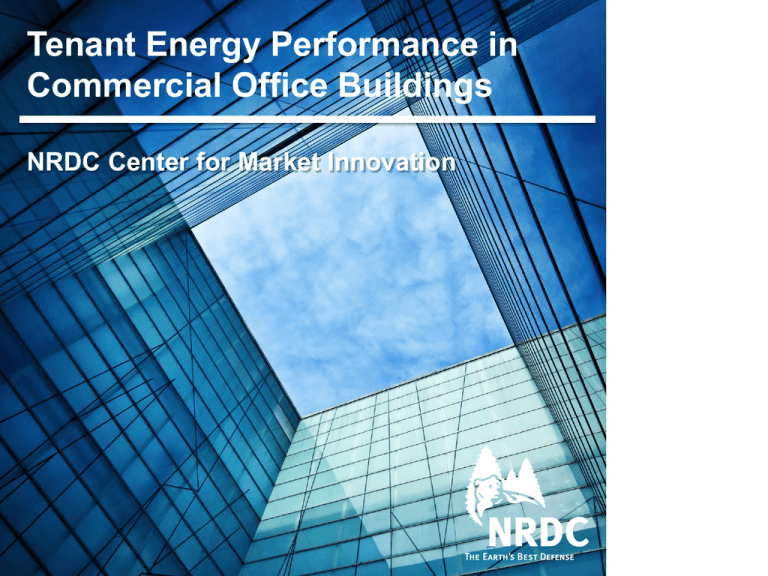
Tenant Energy Performance in
Commercial Office Buildings
NRDC Center for Market Innovation
U.S. COMMERCIAL OFFICE REAL ESTATE IMPACT
12 billion square feet = $20 billion in annual energy costs
2
TENANT OPPORTUNITY
Over 50% of a building’s energy use comes from tenant spaces in
commercial office buildings
Optimize energy performance, quality of spaces and building
services through owner/ tenant collaboration
Base building energy efficiency goals and performance
recognition ratings are enhanced through better tenant
energy performance
3
TENANT OPPORTUNITY
Workplace quality, occupant comfort and satisfaction
improvements are often cited as motivations for high
performance tenant space.
Soft benefits have the potential for greater economic impact
than energy cost savings.
A process of evaluating and quantifying soft benefits is
necessary driver to increase the demand for high
performance tenant space.
4
VALUE PROPOSITION
TENANTS:
REAL ESTATE OWNERS:
↓
↓
↑
↑
↑
↑
↓
↓
↓
energy consumption
operating & maintenance costs
workplace comfort
employee attraction/retention
occupant satisfaction
corporate responsibility &
investor recognition
↑
↑
↑
↑
energy consumption
operations & maintenance cost
capital plan & infrastructure
upgrade cost
occupancy & tenant quality
tenant satisfaction
renewal probability
asset class, value & recognition
5
TENANT ENGAGEMENT
Challenges:
1) Data proving payback of energy
investments
2) Project process/ execution expertise
3) First cost funding solutions
Optimizing energy
performance at
time of build-out,
renovation or
capital work
maximizes ROI
and minimizes
incremental cost
and disruption
6
ENERGY SAVINGS OPPORTUNITIES
Case Study: Empire State Building
Annual Energy Savings (million kBtu)
60
50
DCV
Radiative Barrier
40
Energy Mgmt.
30
Windows
20
10
Retrofit Chiller
Plant
VAV AHUs
Direct Digital
Controls
Lighting/ Daylight
/ Plugs
Base Building Measures
Tenant Space Measures
0
7
QUANTIFIABLE RESULTS
Baseline energy use can be reduced by 30-50%, optimizing
energy performance with a payback of 3-5 years, while providing
a more comfortable and better performing building
8
QUANTIFIABLE RESULTS
Baseline energy use can be reduced by 30-50% compared to:
1) Existing office space
2) Code standard new tenant space
3) Code standard new tenant space + Pre-retrofit base building
Case Study: Coty, Empire State Building
Tenant Electricity Reduction (per Floor)
vs. Adjusted Baseline
vs. ESB Baseline
43.6%
39.2%
34.9%
29.8%
24.4%
19.0%
Good
Better
Best
9
QUANTIFIABLE RESULTS
Baseline energy
useStudy:
can be
reduced
30-50%
compared to:
Case
Coty,
EmpirebyState
Building
Annual
1) Existing
officeTenant
space Electricity Cost Savings (per Floor)
2) Code compliantfrom
standards
ESB Retrofit
from Coty EPMs
3) Code compliant standards + Pre-retrofit base building
$35,000
$30,000
$25,000
$20,000
$9,805
$12,581
$15,393
$14,178
$14,178
$14,178
Good: $23,983
Better: $26,760
Best: $29,571
$15,000
$10,000
$5,000
$0
10
TENANT SPACE ENERGY SAVINGS OPPORTUNITIES
Optimize energy
performance by
addressing all end uses:
1) Reducing loads
2) Installing efficient
equipment
3) Managing behavior
11
LEASE CYCLE ENERGY OPTIMIZATION PROCESS
TENANT SPACE ENERGY SAVINGS OPPORTUNITIES
Tenant Energy Performance Measures (EPMs)
(Optimize results by packaging a group of measures)
Building Owner Support to Tenant EPMs
(Showcase EPMs in a model office suite)
Strategies Provided by Building Owner
Sub-metered by space/ floor/ net lease
Provide specifications to tenant engineer
Building envelope (windows, window film, radiative barrier)
Provide tear sheet with details on capital work EPMs
Strategies with No or Low Additional Incremental First Cost
Select building with natural daylight access
Locate equipment away from windows
Design open office layout
Locate equipment in core, design pre built
Paint walls white or light colors to reflect light
Paint walls white if space is ‘white boxed’
Seal perimeter walls/ openings
Pre seal if perimeter if space is ‘white boxed’
Occupancy sensor/ vacancy sensor lighting controls
Install in pre-build model space
Short Payback Measures
High Efficiency Lighting
Provide specifications and vendors list for competitive bids
Optimize HVAC Units
Provide specifications and vendors list for competitive bids
Plug Load Management
Provide list of technologies and strategies, meet after move-in
IT/ Server Room Load Management
Provide best practices and temperature set points
Medium Payback Measures
Daylight Harvesting Lighting Controls
Provide specifications and vendors list for competitive bids
Demand Control Ventilation (CO2 Sensors)
Coordinate building control systems
Ongoing Management
End use sub-metering- Lighting, plug load, HVAC, IT loads
Ensure building infrastructure supports
tie in of multiple electrical panels
Energy Modeling- Use energy predictive analysis during design,
incentive filing, and measurement and verification
Provide whole building energy model to
Tenant’s engineer
13
TENANT CASE STUDY: LF USA
14
TENANT CASE STUDY: LF USA
15
TENANT CASE STUDY: LF USA
Phase 1 (3 Floors)
Energy Performance Measures
Annual
Electricity
Reduction
(kWh/yr)
Percentage of
Electricity Use
Reduction
from Baseline
Annual
Electricity
Cost Savings
Incremental
First Cost
Simple
Payback
Daylight Harvesting Controls
30,968
3.9%
$5,359
($41,850)
7.8 yrs
High Efficiency Lighting
Right Sized HVAC Units
Demand Control Ventilation (CO2
Sensors)
Plug Load Management
Combined EPM Package (Without
55,746
{0
21,147
7.1%
0%
2.7%
$9,646
$0
$3,659
($30,000)
$0
($47,520)
3.1 yrs
N/A }
13.0 yrs
103,713
218,252
13.2%
27.7%
$17,946
$37,766
($45,000)
($164,370)
2.5 yrs
4.4 yrs
--218,252
--27.7%
--$37,776
$36,940
($6,600)
($134,030)
3.5 yrs
incentives or energy modeling costs)
Net NYSERDA Incentives
Energy Modeling Soft Costs
Combined EPM Package (With
Incentives and energy modeling
costs)
16
TENANT CASE STUDY: LF USA
Phase 1 Build-Out (3 Floors)
Leased Premises
Modeled Energy Reduction
Total Electricity Savings over Lease Term
Incremental Implementation Cost (w/o incentives)
State Incentives (net of review and filing costs)
Energy Modeling Soft Cost
Adjusted Incremental Implementation Cost
Total Electricity Cost Savings over Lease Term
Present Value of Electricity Cost Savings over Lease Term
Net Present Value of Project Investment
Return on Investment (ROI) over Lease Term
Annual Rate of Return
Payback Period
137,400 sq. ft.
28%
3,273,780 kWh
$164,370
$36,940
$6,600
$134,030 ($0.98/ft2)
$566,495
$392,002
$257,972
192%
27%
3.5 years
17
TENANT CASE STUDY: LF USA
Total Build-Out (9 Floors)
Square Footage
Modeled Energy Reduction
Total Electricity Savings over Lease Term
Incremental Implementation Cost (w/o incentives)
State Incentives (net of review and filing costs)
Energy Modeling Soft Cost
Adjusted Incremental Implementation Cost
Total Electricity Cost Savings over Lease Term
Present Value of Electricity Cost Savings over Lease Term
Net Present Value of Project Investment
Return on Investment (ROI) over Lease Term
Annual Rate of Return
Payback Period
412,200 sq. ft.
31%
10,519,320 kWh
$511,110
$124,876
$19,800
$406,034 ($0.99/ft2)
$1,813,733
$1,255,062
$849,028
209%
29%
3.4 years
18
LESSONS LEARNED
Make it easier to get to “yes”:
Start early
Involve top leadership/ decision makers
Incorporate an integrated process
Facilitate knowledge sharing
Design tiers of performance solutions
Provide economic frameworks
Time and iterate the value analysis
Document and measure results
19
LESSONS LEARNED
Motivators:
Recognition/ marketing
Better workplace quality
Energy cost savings
20
TENANT DEMONSTRATION PROJECTS
1)
2)
3)
4)
5)
6)
LF USA:
Coty:
Bloomberg LP:
Reed Smith:
INTEC:
Relay GSE:
Empire State Building/ Malkin Holdings
Empire State Building/ Malkin Holdings
120 Park Avenue/ Global Holdings
3 Logan/ Brandywine Realty Trust
3 Flint Hill/ First Potomac Realty Trust
40 W. 20th/ NRDC
21
TENANT RESOURCES
Process guides:
Energy Performance Opportunities in Commercial Buildings
(10-step Lease Cycle Energy Optimization Process)
Energy Performance Optimization
(Project Development and Value Analysis Process)
Tools:
Energy Modeling RFP Template
Energy Modeling Report Template
Incremental Costing Template
Value Analysis Calculator
Case Studies:
Li & Fung USA
SKANSKA
NRDC DC
22
TENANT ENGAGEMENT SOLUTIONS
Challenges:
1) Data proving payback of energy investments
2) Project process/ execution expertise
3) First cost funding solutions
a) Tiered Tenant Improvement Allowance
b) 3rd Party Energy Service Agreement Model
c) NYCEEC Pilot
23
FOR MORE INFORMATION:
http://www.nrdc.org/business/CGI/
Wendy Fok
Project Director, High Performance Tenant Demonstration Project
Center for Market Innovation
wfok@nrdc.org
Greg Hale
Director of Efficiency Finance
Center for Market Innovation
ghale@nrdc.org
24
